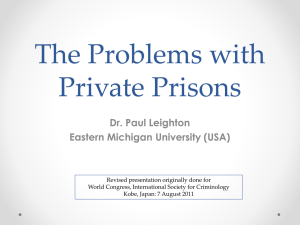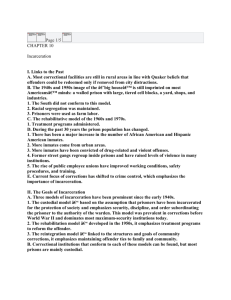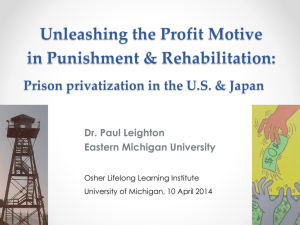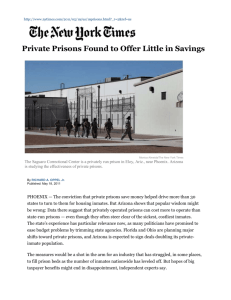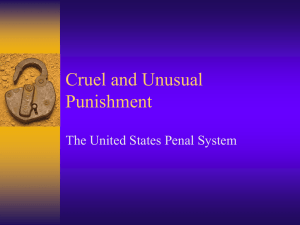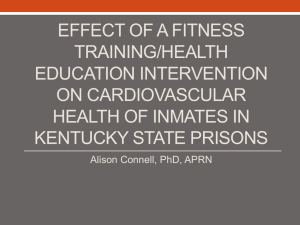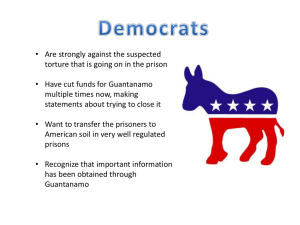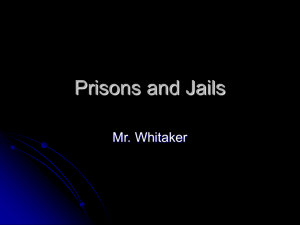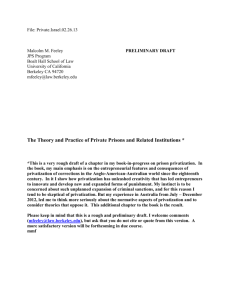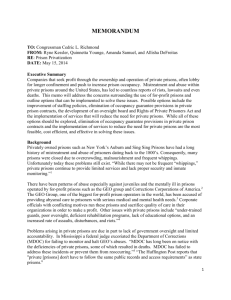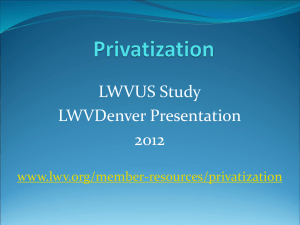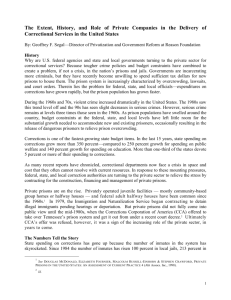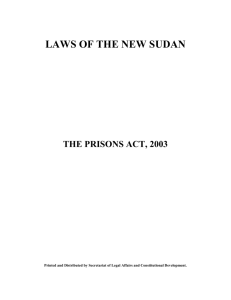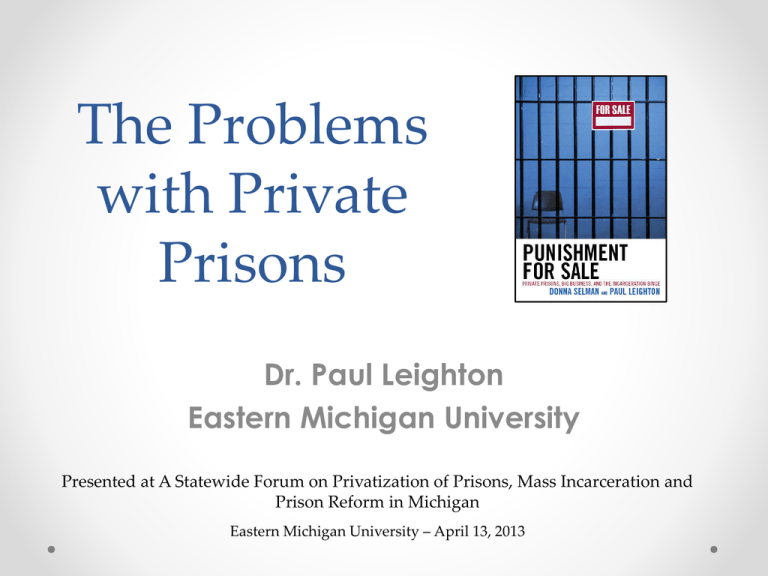
The Problems
with Private
Prisons
Dr. Paul Leighton
Eastern Michigan University
Presented at A Statewide Forum on Privatization of Prisons, Mass Incarceration and
Prison Reform in Michigan
Eastern Michigan University – April 13, 2013
Definition
• Nominal privatization: contracting for
construction, food, medical care, education
• Operational privatization: private company
operates a facility owned by the
government and/or manages inmates in a
prison that the company owns.
Both are real Estate Investment Trusts – pay no federal tax and
distribute money to wealthy shareholders instead
Legitimacy
• No private police (power to arrest, use deadly force)
• No private courts
• Why are private prisons morally acceptable then?
• Would a privatized death row be acceptable?
• Contract out executions if it saved 10%?
• Have a contractor run whole state prison system?
• If NO, then why are we going
down this road?
War on Crime/Drugs
Incarceration Binge
• Overcrowding, need more prisons while promising
smaller govt/lower taxes
• Private prisons raised money from “public” [wealthy]
to continue incarceration binge of poor and profit
Private prisons were
born from unjust policy;
they depend on its
continuation for growth
and profit – need “raw
materials” and “Bodies
destined for profitable
punishment”
Add to Prison-Industrial Complex
• From General/President Eisenhower’s
warning of Military-Industrial Complex
o New permanent armaments industry of “vast proportions”
o “We must guard against the acquisition of unwarranted
influence… The potential for the disastrous rise of
misplaced power exists and will persist. We must never let
the weight of this combination endanger our liberties or
democratic processes.
• Complex forms policy in own interest,
minimizes outside scrutiny and
accountability
o “Iron Triangle” of legislators, bureaucrats and corp interests
“Endanger democratic processes”
GEO Group, 2010 Annual Report “Risk Factors”:
• the demand for our services could be adversely
affected by the relaxation of criminal or immigration
enforcement efforts, sentencing or deportation
practices, and the decriminalization of certain activities.
For example, any changes with respect to the
decriminalization of drugs could affect the number of
persons arrested, convicted, sentenced and
incarcerated, thereby potentially reducing demand for
correctional facilities to house them.
Follow the $
Overhead costs
• Executive pay, executive pay consultants
• Customer acquisition (lobbying, political donations)
• Lawyers for Securities and Exchange Commission
filings
• Investor relations, shareholder lawsuits
• Consultants for mergers, acquisitions, reorganization
• Auditing (international operations)
How can they supposedly do it cheaper
and make a profit?
Promote Inequality: Top Wage in
Public DOC v Private Prisons, 2007
State/
Company
GEO
CCA
California
Texas
New York
Michigan
Georgia
Florida
Ohio
Position
Chairman, CEO
President, CEO
Secretrary
Executive Director
Deputy Commissioner
Director
General Counsel
Secretary
Director
Salary
$2,926,813
$1,887,951
$225,000
$165,000
$157,069
$145,000
$131,908
$128,750
$118,205
Inmates
Fiscal
Under
Responsibility
Supervision ($billions)
54,000
$1.0
72,000
$1.5
172,365
$5.7
153,489
$2.9
63,315
$2.7
51,577
$1.6
47,717
$1.2
86,619
$2.2
47,086
$1.3
CEO salary excludes stocks and stock options. Inmates under supervision excludes probation and parole.
From Selman and Leighton, Punishment for Sale (Rowman and Littlefield, 2010)
Follow the $
• Able to make profit and provide the same service
with higher overhead costs by screwing the
people who work in the prisons
• Median earnings in 2006 for correctional officers
and jailers was
o $35,760 for government employees
o $25,050 for private prisons
• Lower wages = More employee turnover
Source: Bureau of Labor Statistics 2008–2009, quoted in Barak, Leighton &
Flavin (2010) Class, Race, Gender & Crime
Save 5% but weaken
Michigan economy
Private
Public
$
Michigan salaries
$ out of state for
supplies, food
CEO pay, Wall St lawyers &
consultants, lobbying, campaign
donations, supplies, food, etc
Next steps?
• Data about cost savings unclear, need to privatize
more to get better data….
• Comparison based on daily rate for 90%
occupancy, but if we are only using 86%
occupancy, then actual cost per inmate is higher –
NEED TO USE ACTUAL AMOUNTS PAID & NUMBER OF
INMATES HOUSED
• Cost to state for privatization – prepare proposals,
evaluate bids, negotiate contract, monitor. IF WE
DID NOT HAVE PRIVATIZATION, THEN STATE WOULD
NOT INCUR THESE COSTS
Contract Problems
• Weak and flawed systems of monitoring
• Companies deal with more contracts and better
understand the profit-making potential of certain
contractual language
o Maintenance
• Few penalties for violating contract, insufficient for
deterrence
• “Take or Pay”: Pay for 90 or 95% occupancy
regardless of actual number of inmates
o guaranteed revenue for corporation, questionable benefits for
govt that pays for “ghost” inmates
Conclusion
• Questionable legitimacy
• Poor transparency (corp secrets)
• Poor contracts
• Little cost savings
• Add to inequality
• Weaken state economy
• Add to prison-industrial
complex/vested interests in more
unjust mass incarceration
• Corporate interests corrupt
democratic policy- making about
justice and public safety
Dr. Paul Leighton is a professor in the
Department of Sociology, Anthropology &
Criminology at Eastern Michigan University.
More information about him is available on his
website,
http://paulsjusticepage.com/paul/pauls-cv.htm
I believe and hope my use of the images in this
Presentation is covered by ‘fair use.’ Requests to
remove materials should be sent to the presenter
through his address on this page
http://paulsjusticepage.com/paul.htm
Eastern Michigan University, April 13, 2013

